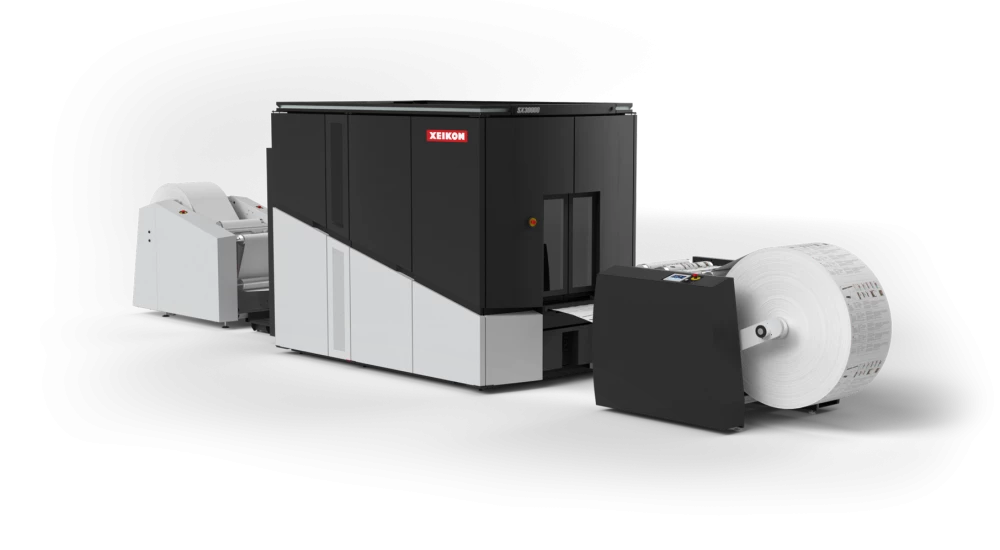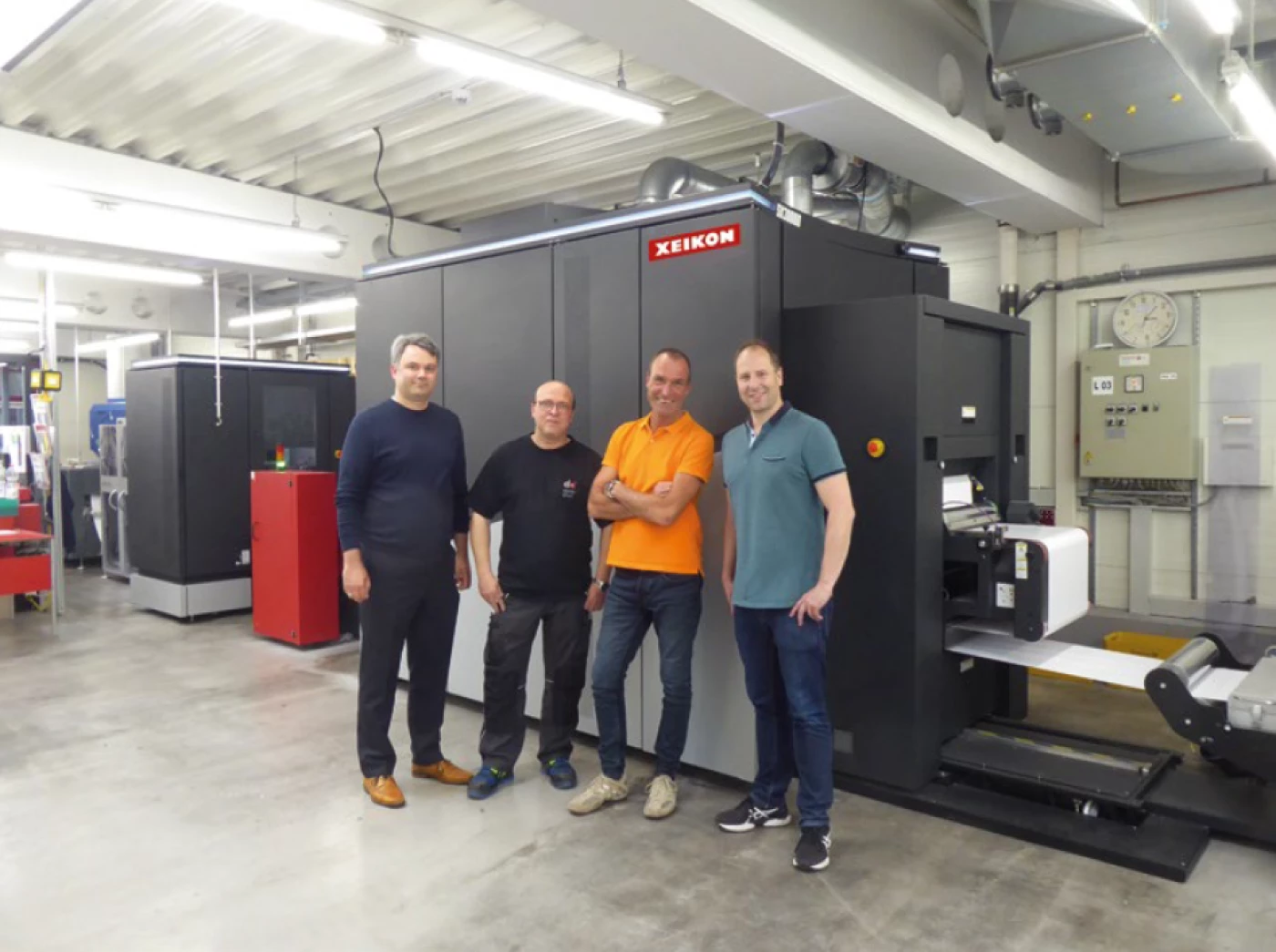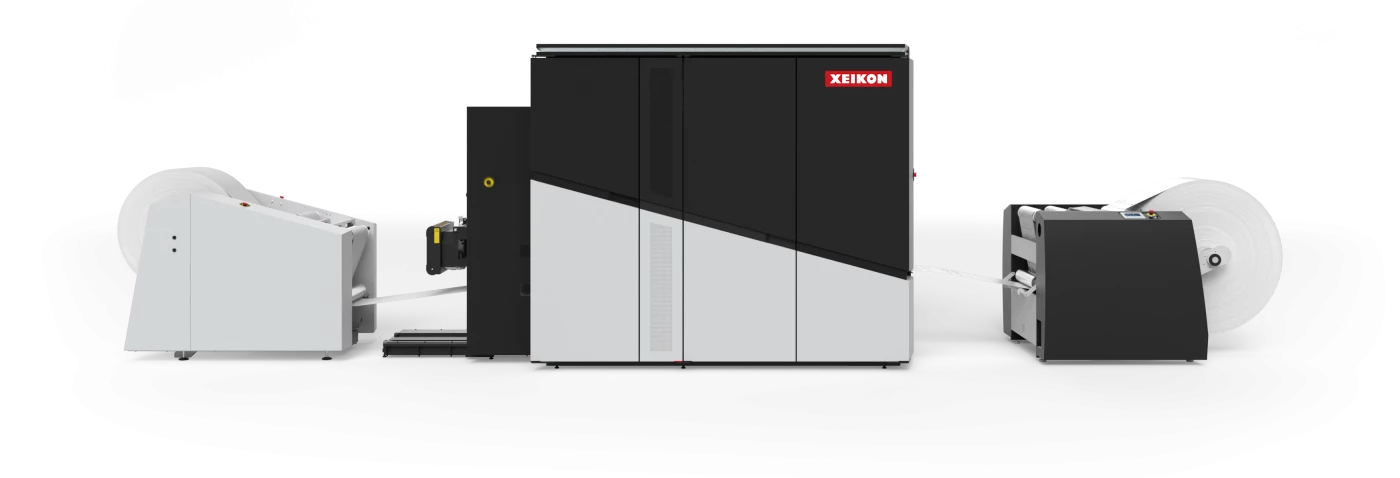29/08/2022
by Dimitri Van Gaever
In October 2021, Duma Druck, based in Wolfschlugen, Germany, became the first company in the country to install a new Xeikon SX30000 reel-to-sheet press. We thought we’d check in with them to see how they got on with this new technology. Deutscher Drucker spoke to the joint Managing Directors of Duma Druck, Frank Illi and Volker Lück.
Interview: Bernhard Niemela
Investing in a Xeikon SX30000 marked Duma Druck’s entry into high-performance digital print. We wondered how it went for them.
You installed a Xeikon SX30000 web press back in October 2021. How did it go?
Lück: Fitting the press into what was quite a tight space was a bit tricky, but it all worked out well. Once all the components were on site, the press was put together piece by piece. We had a photographer do a time-lapse shoot to document the installation process. Watching that now, it’s really quite impressive seeing it all come together. We were curious to see if it would all work out, because this was not only the first installation of an SX30000 in Germany, but also the first time it was combined with Tecnau finishing solutions in this way.
Were you able to start production straight away?
Lück: First of all, we completed the Fogra ProcessStandard Digital (PSD), supported by IPM Müller and Resing GmbH. We were keen to have the PSD certification from the get-go, as this is important not only for our process stability and print quality, but for our customers, too. We also adhere to the PSO standard in offset printing. This reassures the customer that we will always achieve a homogeneous, consistently high-quality result, regardless of the printing process, whether it’s offset or digital. This is really important to the customer.
How many operators do you have working on this press?
Lück: There are two. Fortunately, we were able to take on two members of staff from an insolvent company who already had a great deal of experience working with a Xeikon 8500. This meant that training needs were fairly minimal. Of course, there were new procedures with the new press, but the two of them were familiar with the software and the overall concept. Training for the new Tecnau equipment took a little longer, though.
How many shifts are you running the Xeikon press?
Illi: We run the press between one and a half to two shifts, depending on requirements. Having said that, the shifts slightly overlap, so they’re not full shifts. This allows one operator to take care of standard machine maintenance, while the other deals with printing, meaning we have no unnecessary downtimes.
When I came to see you about a year ago, I asked what production volume would set the limit between using offset or digital. At the time, you predicted it would probably be at around 1,000 units; did this turn out to be the case?
Illi: It is fair to say, that our Heidelberg SM 52 press has reduced its output, with shorter runs now all being handled digitally. I still stand by the batch size of 1,000 units; however, this is size-related.
Lück: For our customers in the agrochemical industry, customised coding has become increasingly important. Without the new Xeikon press, we would not have been able to fully meet those requirements. In this context, the possibility of offering an additional security varnish to the job with the new printing system is also extremely important.
Illi: We also checked beforehand whether we could implement such codes using a separate imprint, however, this would never achieve as homogeneous an image as a single printing process can. The SX30000 demonstrates extremely high definition, especially with smaller font sizes.
Have there been opportunities for new applications with potential new customers?
Lück: In terms of new products, we haven’t gotten quite that far yet, for the simple reason that the Xeikon press is already operating at capacity.
Illi: When we started out, we expected the capacity curve to increase gradually, but instead it shot up pretty quickly, going from 0 to 60 in a very short space of time. We had originally envisaged about half a million clicks per month, but we are at 2 million already.
The new digital printing press has now been in operation for 10 months. What have you learned so far?
Lück: For one thing, we found that purchasing a reel-to-sheet press with the Tecnau solution was the right thing to do, as this combination offers a great deal of flexibility.
Illi: Another experience we had was that static is a bigger problem in digital print. This meant we had to integrate additional ionisation solutions on the finishing side.
Lück: We also found that, when changing the paper roll, it's best to limit the amount of substrate changes and focus on specific paper grades or weights. If we were to broaden our portfolio, we would have to adjust the variety of available substrates, which would also lead to additional make-ready times. Fewer roll changes means the press can operate more efficiently.
How have you integrated the press with your existing workflow?
Lück: Once the data has been prepared in prepress, it is allocated to the relevant workflow – offset or Xeikon server – via a network server. We don’t have direct access from prepress to the digital press. This has worked out well for us, as it gives us the flexibility for the operator to decide on site what should be prioritised and what shouldn’t, and how to approach the roll changes.
So, bottom line: does the press deliver on its promise?
Illi: One hundred per cent. It is safe to say that it was the best decision for us. The press does exactly what it’s supposed to do, and just keeps on running. We’ve not had a single complaint yet.
Clearly, your entry into digital print has been a success. What next in terms of digital?
Illi: With the SX30000, we took our first steps into digital printing, and we will continue to monitor market developments. An investment like another digital printing system is not a short-term decision for a medium-sized company like ours, however. In addition, price increases in the paper market, but also the wider economic situation, make planning ahead quite difficult. From a purely technical point of view, though, there is an exclamation mark rather than a question mark after the expansion of digital print.


